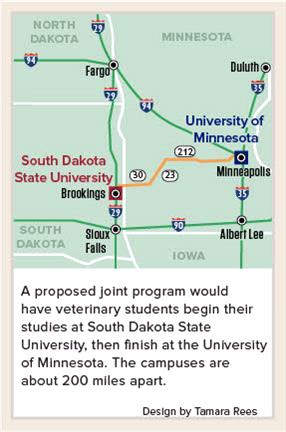S. Dakota-Minnesota veterinary school plan advances

 A proposal for a veterinary school program that starts at South Dakota State University and ends at the University of Minnesota is moving ahead now that it has secured a general endorsement from the South Dakota Veterinary Medical Association.
A proposal for a veterinary school program that starts at South Dakota State University and ends at the University of Minnesota is moving ahead now that it has secured a general endorsement from the South Dakota Veterinary Medical Association.
Dennis Hedge, provost and vice president of academic affairs at SDSU, said he expects veterinary medical education to be on the agenda at one or both of the next two meetings of the Board of Regents, scheduled for early October and early December.
Hedge said SDSU will give regents an in-depth plan — currently a draft under internal review — that details curriculum, faculty expertise, student affairs, budgeting, recruitment, research capabilities, facilities, academic degrees and industry relations, among other areas.
Until the report is forwarded in its final form to the Board of Regents, Hedge said, he is unable to discuss particulars with the public.
An earlier report prepared by a task force in 2016 and updated in 2017 described a prospective program providing 20 slots per year, with South Dakota residents filling at least half. The remainder would go to applicants from other states in the region.
Ten to 12 South Dakota residents a year on average historically have entered a U.S. veterinary school, according to the task force report.
The task force estimated that a program at SDSU would cost $6 million to set up and $1.41 million a year to operate.
The proposal originated with Dr. Trevor Ames, dean of the UMN College of Veterinary Medicine, as a way to attract more students interested in rural practice. Thirty to 40 percent of UMN veterinary students focus on mixed animal and food animal medicine, according to Ames. UMN enrolls slightly more than 100 new veterinary students each year.
Program advocates for the past year were awaiting feedback from veterinarians and ranchers on the idea. A 15-member committee representing stakeholders in South Dakota — including nine veterinarians and producers of cattle, hogs, poultry and sheep — formed last fall intending to develop a consensus position on the joint schools idea by Jan. 1. However, ultimately they did not do so, according to Dr. Travis White, immediate past president of the SDVMA, who chaired the committee.
Jennifer Stalley, executive director of the SDVMA and a member of the committee, explained that scheduling conflicts made it difficult for the group to meet more than once, and the amount of information that participants needed to absorb about the plan made it unrealistic for them to reach a consensus in a single day.
"Honestly, there were legitimate lingering questions," she said. "People weren’t able to say, 'We 100 percent support it' " at that time.
Some worried about unnecessarily adding to the "stream of veterinarians" in the workforce, Stalley said. Some wondered how the school would function as a recruitment tool for only rural practitioners.
"We as a stakeholder group asked more questions than provided any specific opinion. We decided to leave it to each group to determine where they'd be for any specific proposal," she said.
For its part, the SDVMA tackled the question during its annual meeting in mid-August. Ames from UMN and SDSU President Barry Dunn gave a presentation to and answered questions from an audience of about 140 members, Stalley said.
"It’s fair to say that Dunn and Ames presented a very solid case for why and how this would work," she reported.
To the concern about unnecessarily adding more veterinarians to the workforce, Stalley said Ames indicated that Minnesota could keep its program size constant by reducing the number of students it accepts from Caribbean veterinary schools. Those schools send fourth-year students to programs in the United States and Canada for clinical training. Ames told the VIN News Service last fall that Minnesota historically averages 20 to 25 Caribbean students a year, with the majority interested in pursuing companion animal practice.
On the rural practice question, Stalley said Ames and Dunn explained that by exposing students to large animal and mixed animal practice, through using adjunct professors and in clinical rotations, students in the program naturally would gravitate to the field. The reasoning is along the lines of "If you're exposing students to rural practice, it's not as formidable to commit to that type of practice," Stalley said. By comparison, "If all you've ever done is small animal practice and now you're expected to live in rural South Dakota, that's probably not going to be a good fit for you."
After the presentation by Ames and Dunn, at a separate session attended by about 60 members, Stalley reported, the SDVMA by a voice vote approved a resolution supporting "the establishment of a regional veterinary medical education program for educating veterinary medical students dedicated to serving agricultural communities and fostering excellence in diagnostics, research and clinical practice."
Stalley noted that the group opted to approve the concept broadly in order to signal its welcome to more such regional collaborations.
"If tomorrow, Idaho were to approach South Dakota, there would be the same level of enthusiasm to support that opportunity," she said. "We believe the concept of combining resources and expertise should be supported."
A SDSU-UMN joint veterinary program would be the fifth such collaboration in the country. Currently, partnerships exist at the University of Nebraska with Iowa State University; Utah State University with Washington State University; Montana State University also with Washington State University; and the University of Alaska with Colorado State University.